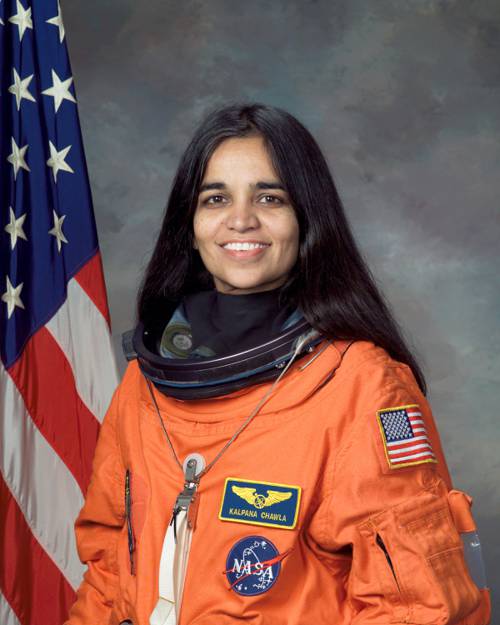
FAQ About Kalpana Chawla

Who was Kalpana Chawla?
Kalpana Chawla was an American astronaut and aerospace engineer who was the first woman of Indian origin to go to space. Born on March 17, 1962, in Karnal, India, she first flew on the Space Shuttle Columbia in 1997 as a mission specialist and primary robotic arm operator.

When did Kalpana Chawla go to space for the first time?
Kalpana Chawla first traveled to space on November 19, 1997, as part of the Space Shuttle Columbia's STS-87 mission. She served as a mission specialist and was responsible for deploying the Spartan satellite using the robotic arm.

What was Kalpana Chawla's role in her first space mission?
During her first mission, STS-87 in 1997, Kalpana Chawla served as a mission specialist and primary robotic arm operator. She was responsible for deploying and retrieving the Spartan satellite, though the mission encountered challenges with its deployment.

How did Kalpana Chawla die?
Kalpana Chawla tragically lost her life on February 1, 2003, when the Space Shuttle Columbia disintegrated upon re-entering Earth's atmosphere. All seven crew members aboard perished in the disaster.

How many space missions did Kalpana Chawla participate in?
Kalpana Chawla participated in two space missions: STS-87 in 1997 and STS-107 in 2003. Her second mission ended in tragedy with the Columbia disaster during re-entry.

What was the purpose of Kalpana Chawla's second space mission?
Kalpana Chawla's second space mission, STS-107, aimed to conduct around 80 experiments in life sciences, material sciences, fluid physics, and other fields. The mission gathered extensive data on how weightlessness affects physical and biological systems.

Where did Kalpana Chawla grow up?
Kalpana Chawla grew up in Karnal, a city in the northern Indian state of Haryana. Her early education and passion for aeronautics and space were primarily nurtured in this environment.

What educational qualifications did Kalpana Chawla have?
Kalpana Chawla held a Bachelor of Engineering degree in Aeronautical Engineering from Punjab Engineering College, India. She later obtained a Master of Science degree in Aerospace Engineering from the University of Texas at Arlington, and a Ph.D. in Aerospace Engineering from the University of Colorado Boulder.

What impact did Kalpana Chawla have on space exploration?
Kalpana Chawla's contributions to space exploration extend beyond her missions. As a pioneer for women and individuals of Indian origin in space, her legacy has inspired many to pursue careers in aerospace and engineering. Her dedication and passion continue to motivate new generations of scientists and astronauts.

What awards did Kalpana Chawla receive for her contributions to space and science?
Kalpana Chawla was posthumously awarded the Congressional Space Medal of Honor, the NASA Space Flight Medal, and the NASA Distinguished Service Medal for her contributions and sacrifice in the field of space exploration.

How has Kalpana Chawla been honored in India and across the world?
In India, several educational institutions, awards, and initiatives have been named after Kalpana Chawla to honor her legacy. Internationally, asteroids, scholarships, and numerous buildings bear her name as a tribute to her contributions to space exploration and her inspirational influence.

What was Kalpana Chawla’s educational journey to become an astronaut?
Kalpana Chawla's educational path began at Punjab Engineering College where she studied Aeronautical Engineering. She moved to the United States for further studies, obtaining a Master of Science at the University of Texas at Arlington and a Ph.D. at the University of Colorado Boulder. Her academic excellence and passion for flight led her to join NASA's space program.

What were the scientific outcomes of Kalpana Chawla's final mission, STS-107?
Despite the tragedy of STS-107, the scientific data collected during the mission has been invaluable. The experiments conducted provided insights into the effects of microgravity on biological and physical systems, and some experiments' results were able to be reconstructed from data transmitted before the disaster.

Why is Kalpana Chawla considered a role model?
Kalpana Chawla is considered a role model due to her achievements as a woman of Indian descent in the predominantly male field of aerospace. Her journey from a small town in India to becoming an astronaut exemplifies determination, hard work, and breaking barriers, inspiring many around the world.

What challenges did Kalpana Chawla face in her career?
Kalpana Chawla faced numerous challenges including cultural expectations, rigorous academic demands, and stringent NASA astronaut selection processes. Despite these, her perseverance and passion for space propelled her to succeed in her field.

What was Kalpana Chawla's contribution to the STS-107 mission?
On the STS-107 mission, Kalpana Chawla played a crucial role in conducting science experiments across various disciplines. She worked extensively on studying atmospheric dust to understand climate changes and leveraged her expertise to maximize the mission's scientific output.

How is Kalpana Chawla's legacy preserved today?
Kalpana Chawla's legacy is preserved through various scholarships, educational programs, and awards established in her name. Her story is a staple inspiration in aerospace academia and is frequently highlighted to encourage diversity and gender equality in STEM fields.

What were some of the key fields of research in Kalpana Chawla's STS-107 mission?
The STS-107 mission focused on multiple scientific fields, including biology, materials science, physics, and atmospheric research. The mission's experiments aimed to enhance understanding of how different scientific phenomena behave in the microgravity environment of space.

How did Kalpana Chawla inspire women in STEM?
Kalpana Chawla's achievements in a field dominated by men during her time have significantly inspired many women globally to pursue careers in STEM. Her success story amplifies the message that with dedication and effort, gender barriers in science and technology can be overcome.

What kind of experiments did Kalpana Chawla work on during her space missions?
Kalpana Chawla worked on a variety of experiments during her missions, including deploying satellites and studying atmospheric phenomena and microgravity effects on physical and biological processes. These efforts aimed to deepen human understanding of life sciences and physics in space conditions.
